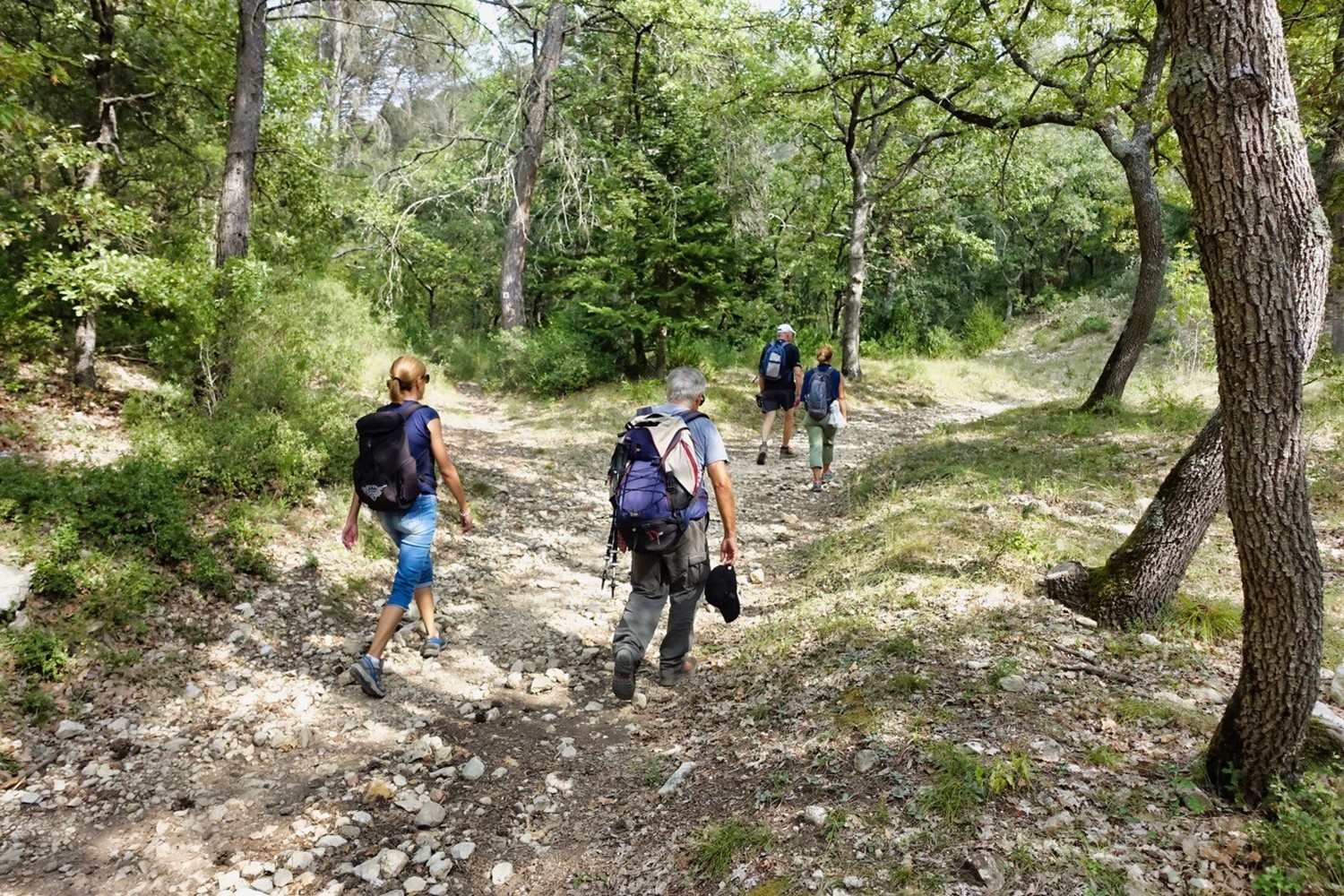
Landscapes of Ansouis
"After a beautiful ascent in the shade of the oaks and pines I see, through the vegetation, Ansouis and its old military fortress. A little while longer, I arrived at the trail of ridges, slightly breathless, and discovered a beautiful panorama on the Grand Luberon. It was worthwhile! The descent on Ansouis ismore relaxing and opens on the plain and Pays d'Aigues. " says Séverine Besson, Task Officer for the Valuation of assets at the south side Luberon Tourist Office.
15 points of interest
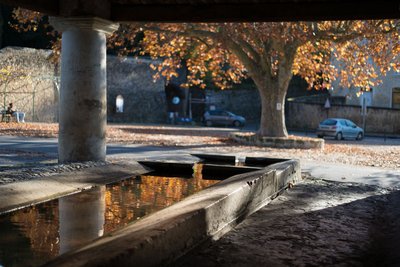
Lavoir d'Ansouis - ©Commune d'Ansouis  Patrimony and history
Patrimony and historyThe washhouse of Ansouis
Typical with two basins - one for washing and a second one for rinsing with the arrival of water, that had to be very clean. The clothes were soaked in the water by the women, then scrubbed with "soap of Marseille" known to be one of the best detergents, then it was roughly struck several times to the “battoir” to evacuate the dirt and the soap. Rinsing required twisting and bending the laundry before draining. Some women made it their profession: The washerwomen.
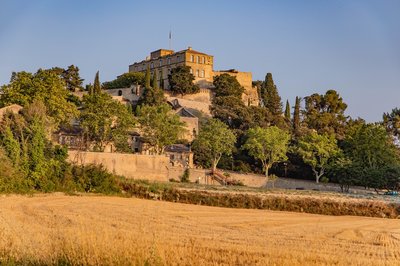
Château et village d'Ansouis - ©Alain Hocquel - VPA  Patrimony and history
Patrimony and historyAnsouis, a hilltop village
The village developed from the 10th century around the castle and the church (11th century) located at the top of a hillock. Positioned at a strategic intersection of old roads, Ansouis was the administrative and trading centre of a barony consisting of Cucuron, Sannes and Motte d'Aigues. Less influential (crisis of the 18th century), less populated (rural exodus of the19th century), the village has kept its dense urban form of the 16th century making it its charm and a rare and precious proof.
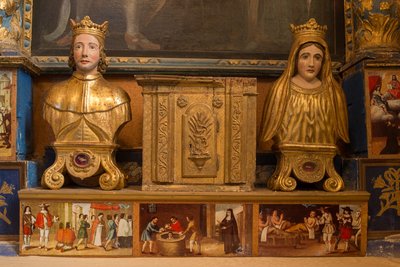
Reliques de Saint-Elzéar - ©Commune d'Ansouis  Patrimony and history
Patrimony and historyPlace Saint-Elzéar
Named Elzéar Sabran who was born in Provence in 1285 and was married to Delphine (Dauphine) sign, which was destined to take orders. They lived their married life in asceticism and virginity. Elzear died September 27, 1325 and was canonized April 15, 1369. Delphine made vows of poverty and ended his life in Apt in the greatest destitution. The Church blessed and proclaimed the popular will, Ste. Ansouis always celebrates in September the Saints.

Galets d'Ansouis - ©DR-Nicoulina  Geology
GeologyWho says "pebbles" said "river"
Towards the top of the hill, the rollers become increasingly abundant. They are in shape, size and colors and sign the existence of an ancient river. For one roller is a piece of rock torn from the mountains by erosion and transported to the bottom of a river or sea, using and is slowly rounding. The rollers of Ansouis have very different origins, and sometimes far as the Alps, brought to this place by a paleo-Durance flowing out there 8 million years.
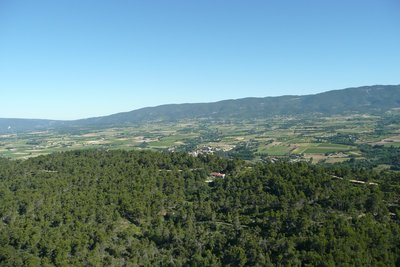
Ansouis et le Grand Luberon - ©Stéphane Legal - PNR Luberon  Panorama
PanoramaView on the Adret of the Grand Luberon
In the distance, you observe the Grand Luberon, whose birth is related to the Pyrenees, about 40 million years ago. Subsequently, the formation of the Alps enhanced the relief, and erosion shaped it. All this, leads to its present structure: A vast asymmetric vault fold, straddling towards the south. This southern flank, eroded by erosion, gave shape to its small hills that can be seen before the Grand Luberon, from Cucuron to Peypin-d'Aigues.
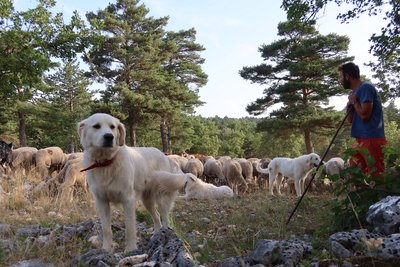
Berger, troupeau et jeunes chiens de protections - ©Solgne Louis - PNR Luberon  Elevage et pastoralisme
Elevage et pastoralismeThe Patis
In Provençal "pati" means "grazing", a ground assigned to the herds. An ancient pastoral activity surely gave its name to the place. Indeed, these natural areas often host flocks. They are still present in other areas. When the land is wooded, the help of animals grazing under the trees, thinning, pruning of the lower branches and brushing, reduces the risk of fire.
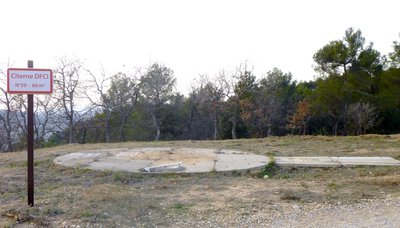
Citerne DFCI - ©Séverine Besson - OT Luberon Sud Tourisme  Savoir-faire
Savoir-faireTanks and fire prevention
When strong wind is blowing, the fire can spread to 10 km/h! The very dry nature, even in winter, can quickly ignite. Looking around, you can easily observe arrangements to prevent the spread of fire: DFCI (defense against forest fires) tanks, fairly wide tracks for the passage of fire trucks and clearings of both sides of these tracks. During the summer season, it is important to learn about the rules of access to the forest massifs (for more information, contact: 08 84 17 8000
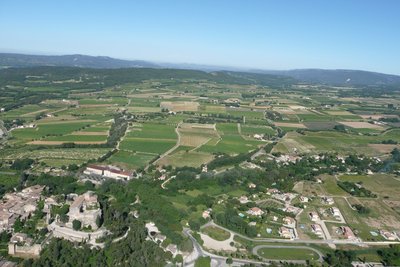
Petit Luberon et Mourre du Cairas à droite - ©Stéphane Legal - PNR Luberon  Panorama
PanoramaA protective mountainous area
Behind the vines of the Pays d'Aigues, stands the Cap de Serre which overlooks Lourmarin at the far left of the landscape. Below, the valley of Lourmarin separates the Grand Luberon to the east of the Petit Luberon to the west. The highest point of the Grand Luberon, the Mourre Nègre, is 1,125m high and overlooks Cucuron. That of the Petit Luberon, the Mourre de Cairas, situated above Mérindol, culminates at 727m. This natural barrier protects Ansouis from the mistral!
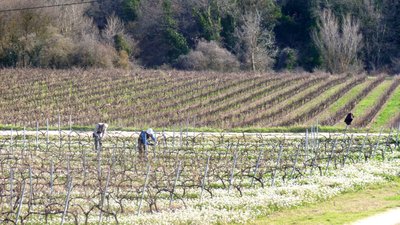
Vignes d'Ansouis - ©Séverine Besson - OT Luberon Sud Tourisme  Produits du terroir
Produits du terroirAnsouisienne Agriculture
The sweetness of the mountainous area, the multitude of rivers and springs and the fertility of the land ensure Ansouis unquestionable benefits for agriculture. Cereals, vineyards, orchards, meadows and varied agricultural fields cover more than three quarters of the total area, or about 1,322 ha. Some of the vineyards of Ansouis are classified AOC Luberon and the Winery Vinicole des Coteaux, created in 1925, now includes 67 vineyards for a surface of 450 ha.

Manon des sources - ©DR- premieres.fr  Patrimony and history
Patrimony and historyAnsouis, movie set
The church of Ansouis has been featured in two cult films of Claude Berri, "Jean de Florette" and "Manon of the Spring" (1986). The scenes of preaching to the Christmas Mass and Manon wedding were all shot in the church. The scenes outside the church happen in Vaugines, at 7 km from Ansouis.

Beffroi d'Ansouis - ©OT Luberon Sud Tourisme  Patrimony and history
Patrimony and historyThe belfry of Ansouis
The council of the community of Ansouis held its sittings in the house of the brotherhood of the Holy Spirit from 1540. After the dissolution of the Brotherhood, the house became communal property and turned into City Hall and oven. above the belfry were built, crowned with a forged iron bell tower, which houses the clock and was probably built between the late sixteenth century. and early seventeenth century. This town hall was replaced by the former town hall on an unknown date between 1793 and 1836.
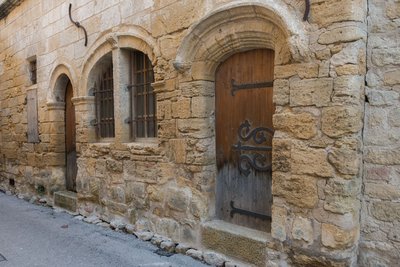
Maison des Consuls d'Ansouis - ©Commune d'Ansouis  Patrimony and history
Patrimony and historyMaison des Consuls
This house was the seat of the City Council in the fifteenth century. and sixteenth century. The lower part has openings hanger topped with moldings which one can think of a window of shop. Indeed, the ground floor housed the grain silos, oven, stalls with meat and fish that were intended, if the village office, to supply the inhabitants who sought refuge in the castle .

Le château d'Ansouis - ©Séverine Besson - OT Luberon Sud Tourisme  Patrimony and history
Patrimony and historyCastle Ansouis
The castle, built in the Middle Ages on top of a rocky outcrop, was a vantage point. Four towers and a central tower, it has a strong fortification system. In the seventeenth century., Peace reigning again in Provence, the castle is transformed into pleasure residence. Occupied for nearly 1000 years by the Sabran family, the new owners since 2008 continues the restoration and the castle open to visitors.

Entrée de l'église Saint-Martin - ©Séverine Besson - OT Luberon Sud Tourisme  Patrimony and history
Patrimony and historyThe Church of St. Martin
Difficult to date this building, it's probably not earlier than the end of the twelfth century. It consists of a three-row nave and an arched transverse vessel broken barrel. various sculptural elements One notices. This church, probably built in the days when the village knew its maximum population, was not enlarged thereafter and suffered only a few minor alterations.
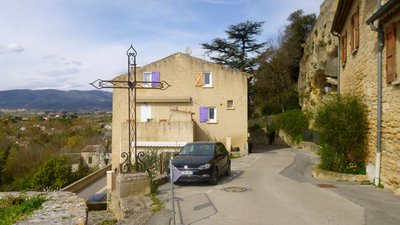
Emplacement du Grand portail - ©Séverine Besson - OT Luberon Côté Sud  Patrimony and history
Patrimony and historyOld entries
There remains only the location of the Grand Portal on the current road. The forged iron cross reinstalled by the parish in 1951 symbolizes this ancient village entrance. The spiral ramp, used today, is modern. Presumably built west of the old, it rests on the north side of the tower. Little Portal, in the street of the same name, is the only door still nowadays state.
Description
From the car park of the Tourist Office, turn left under the porch and follow the road towards the village. At the roundabout, turn right onto the Boulevard des Platanes. Pass the Place Saint-Elzéar and continue straight until the Place des Hôtes.
1- Turn left, take the crossing of the Colombier. Below, at the exit of the curve (big cactus), take the stony trail to the left. At the bottom, follow the road to the left, then turn right and cross the stream Le Marderic. At the sign "Juillère", take the path on the left direction Le Gavède. Go under a house, cross a barrier, and climb a steep path. Cross a second barrier, then continue climbing up the ridge trail.
2- At the top, turn right and follow the forest trail. At the height of the power line, leave a path on the right and continue straight ahead.
3- At the intersection "Coulet Blanc", continue straight in the direction of Villelaure, Vieux Moulin. Pass in front of a house, leave a path to the left, then, 100m further, turn to the right. Go straight ahead, cross a barrier, and then a second leading to the hamlet of Font-Blanche. Continue twice to the right, cross the small bridge over Le Marderic and reach the Route de Pertuis (D37).
4- Take the right for 300m and after the turn, turn right on the paved road of the Vieux Moulin. Go back to the village, go back to point 1 and reach the Place des Hôtes. Go further and turn left into the Rue du Petit Portail. 30m later, climb the stairs to the right. Go left in the Rue du Grand Four, then go up to the Place du Château.
5- Go back, go down to the first intersection, and turn right onto Grande Rue. Continue right on Rue de France and return to Place de la Vieille Fontaine and the Tourist Office.
- Departure : Tourist Office, Place de la Vieille Fontaine, Ansouis
- Arrival : Ansouis
- Towns crossed : Ansouis
Forecast
Altimetric profile
Recommandations
Be careful on the return by taking the road of Pertuis (D37) on almost 300m.
Information desks
House of the Luberon Regional Nature Park
60, place Jean Jaurès, 84400 Apt
In the heart the old town centre of Apt, the House of the Luberon Regional Nature Park welcomes you in a town house of the 18th century. The permanent exhibition of the geology museum has a rich collection of fossils evidencing the geological history of the Luberon.
On sale at the shop: books, maps, guidebooks, games, posters...
Open Monday to Friday from 8:30 am to 12:00 pm and from 1:30 pm to 6 pm (and on Saturday, depending on the program). Free admission.
OTI Luberon Sud Tourisme
Le Château - BP 16, 84240 La Tour d'Aigues
Access and parking
At 8km North of Pertuis, through the D56 and the D37.
Parking :
Access
- Emergency number :
- 114
More information
Source

Report a problem or an error
If you have found an error on this page or if you have noticed any problems during your hike, please report them to us here:


